Valid 98-366 Dumps shared by PassLeader for Helping Passing 98-366 Exam! PassLeader now offer the newest 98-366 VCE dumps and 98-366 PDF dumps, the PassLeader 98-366 exam questions have been updated and ANSWERS have been corrected, get the newest PassLeader 98-366 dumps with VCE and PDF here: https://www.passleader.com/98-366.html (220 Q&As Dumps –> 261 Q&As Dumps)
BTW, DOWNLOAD part of PassLeader 98-366 dumps from Cloud Storage: https://drive.google.com/open?id=0B-ob6L_QjGLpVVhXZTVKdDJpSnc
QUESTION 101
What is the DNS record type that specifies an alias name of another address record?
A. MX
B. CNAME
C. NS
D. SOA
Answer: B
Explanation:
CNAME stands for Canonical Name. CNAME records can be used to alias one name to another.
QUESTION 102
This question requires that you evaluate the underlined text to determine if it is correct. Select the correct answer if the underlined text does not make the statement correct. Select “No change is needed” if the underlined text makes the statement correct.
Each IPv4 address consists of a MAC address and data-link laver address.
A. Network ID and a host ID
B. DNS record and a default route
C. 64-bit binary number divided into octets
D. No change is needed
Answer: A
Explanation:
Each IP address is separated internally into two parts — a network ID and a host ID.
QUESTION 103
This question requires that you evaluate the underlined text to determine if it is correct. Select the correct answer if the underlined text does not make the statement correct. Select “No change is needed” if the underlined text makes the statement correct.
The NTP value in a resource record indicates a length of time that other DNS servers use to determine how long to cache information for a record before expiring and discarding it.
A. TTL
B. GPS
C. SOA RR
D. No change is needed
Answer: A
Explanation:
Time to live (TTL) is what dictates how long it will be until your computer refreshes its DNS related information.
QUESTION 104
Hotspot
For each of the following statements, select Yes if the statement is true. Otherwise, select No. Each correct selection is worth one point.
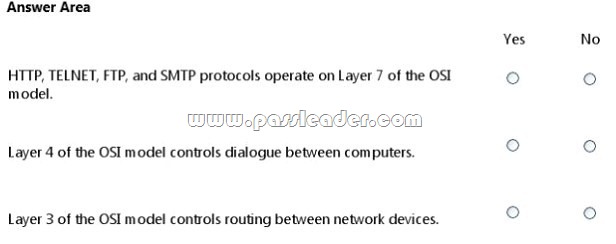
Answer:
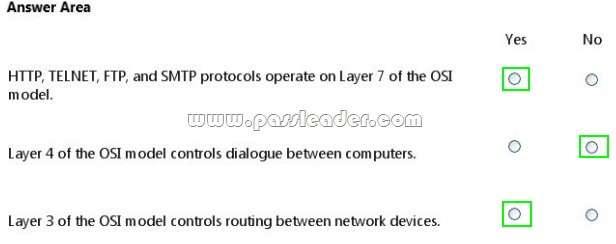
Explanation:
– Layer 7 TCP/IP protocols include:
* HTTP, Hypertext Transfer Protocol
* Telnet, a remote terminal access protocol
* SMTP, Simple Mail Transfer Protocol
* TFTP, Trivial File Transfer Protocol, a simple file transfer protocol
– The session layer (layer 5) controls the dialogues (connections) between computers. The transport layer provides the functional and procedural means of transferring variable-length data sequences from a source to a destination host via one or more networks, while maintaining the quality of service functions.
– The network layer provides the functional and procedural means of transferring variable length data sequences (called datagrams) from one node to another connected to the same network. It translates logical network address into physical machine address. A network is a medium to which many nodes can be connected, on which every node has an address and which permits nodes connected to it to transfer messages to other nodes connected to it by merely providing the content of a message and the address of the destination node and letting the network find the way to deliver (“route”) the message to the destination node.
QUESTION 105
Hotspot
You are studying for finals in the student lounge. When your laptop is connected to the wireless network, access to the Internet is slow. When you plug your laptop into a wall jack, you can no longer access the Internet at all. You run the ipconfig /all command. The results are shown in the following image:
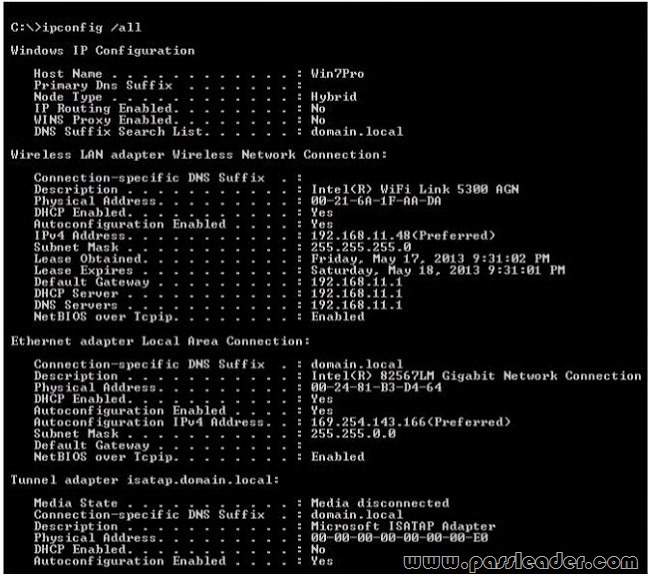
Use the drop-down menus to select the answer choice that completes each statement. Each correct selection is worth one point.
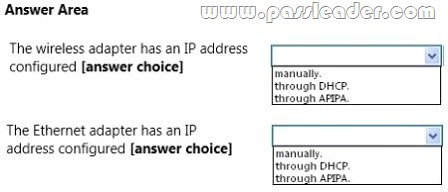
Answer:
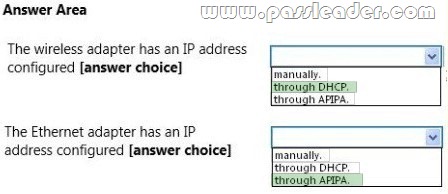
Explanation:
The wireless adapter is DHCP enabled and has a normal IP address of 192.168.11.1. The Ethernet adapter is also DHCP enabled but has an APIPA IP address of 169.254.143.166.
QUESTION 106
Hotspot
For each of the following statements, select Yes if the statement is true. Otherwise, select No. Each correct selection is worth one point.
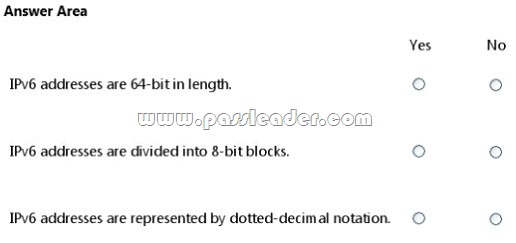
Answer:
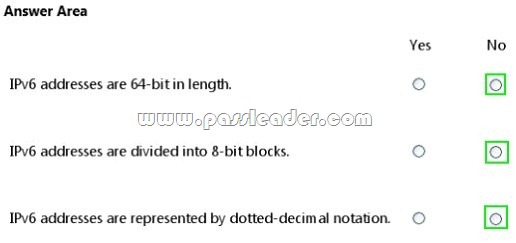
Explanation:
– IPv6 addresses are 128 bit in length.
– IPv6 addresses are written in eight groups of four hexadecimal digits separated by colons, such as 2001:0db8:85a3:0000:0000:8a2e:0370:7334.
QUESTION 107
Hotspot
Where in the diagram is a T3 connection possible? To answer, select the appropriate connection in the diagram in the answer area.
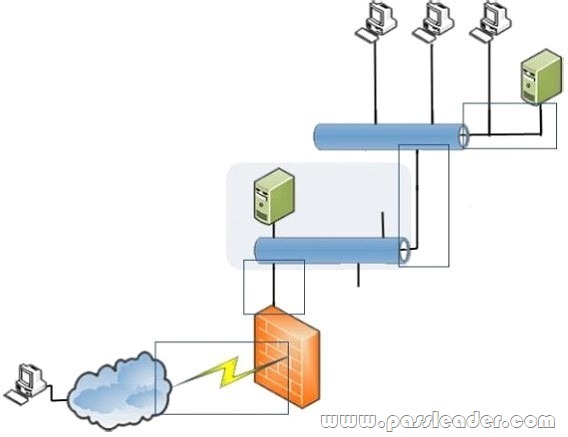
Answer:
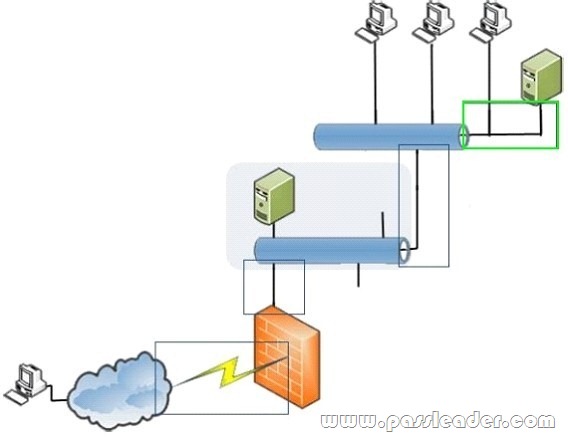
Explanation:
T3 lines are a common aggregation of 28 T1 circuits that yields 44.736 Mbps total network bandwidth . Besides being used for long-distance traffic, T3 lines are also often used to build the core of a business network at its headquarters.
QUESTION 108
What happens when an 802.11a node broadcasts within the range of an 802.11g access point?
A. The access point transmits, but the node is unable to receive.
B. A connection occurs.
C. Both the node and the access point are unable to transmit.
D. The node transmits, but the access point is unable to receive.
Answer: D
Explanation:
Because 802.11a and 802.11b utilize different frequencies, the two technologies are incompatible with each other. A huge problem with 802.11a is that it’s not directly compatible with 802.11b or 802.11g networks. In other words, a user equipped with an 802.11b or 802.11g radio card will not be able to interface directly to an 802.11a access point.
QUESTION 109
One advantage of dynamic routing is that it ____.
A. Automatically maintains routing tables.
B. Limits traffic derived from routing protocols.
C. Reduces broadcast traffic.
D. Automatically enables DHCP.
Answer: A
Explanation:
Dynamic Routing, also called adaptive routing, describes the capability of a system, through which routes are characterized by their destination, to alter the path that the route takes through the system in response to a change in conditions. The adaptation is intended to allow as many routes as possible to remain valid (that is, have destinations that can be reached) in response to the change.
QUESTION 110
Which of the following represents a Media Access Control (MAC) address?
A. GV:ZC:KK:DK:FZ:CA
B. 255.255.255.0
C. 05:35:AB:6E:Al:25
D. 127.0.0.1
Answer: C
Explanation:
The standard (IEEE 802) format for printing MAC-48 addresses in human-friendly form is six groups of two hexadecimal digits, separated by hyphens (-) or colons (:), in transmission order (e.g. 01-23-45-67-89-ab or 01:23:45:67:89:ab ).
QUESTION 111
Connecting to a private network address from a public network requires ____.
A. Network address translation (NAT)
B. Dynamic Host Configuration Protocol (DHCP)
C. Network Access Protection (NAP)
D. Dynamic domain name system (DDNS)
Answer: A
Explanation:
The majority of NATs map multiple private hosts to one publicly exposed IP address. In a typical configuration, a local network uses one of the designated “private” IP address subnets (RFC 1918). A router on that network has a private address in that address space. The router is also connected to the Internet with a “public” address assigned by an Internet service provider.
QUESTION 112
A network device that associates a Media Access Control (MAC) address with a port is a ____.
A. DSL modem
B. Hub
C. Router
D. Switch
Answer: D
Explanation:
A switch begins learning the local MAC addresses as soon as it is connected to other devices or to a network. This learning capability makes switches easy to use on a network. The switch learning process works like this:
1.As a PC or other networked device sends a frame to another device through the switch, the switch captures the source MAC address of the frame and the interface that received it.
2.The switch confirms or adds the MAC address and the port to the lookup table.
QUESTION 113
A Layer 2 device that connects multiple computers within a network is a ____.
A. Repeater
B. Switch
C. Router
D. Packet
Answer: B
Explanation:
Layer 2 switching uses the media access control address (MAC address) from the host’s network interface cards (NICs) to decide where to forward frames.
QUESTION 114
A cable that meets the l000BaseT standard has a maximum length of ____.
A. 100 m
B. 250 m
C. 500 m
D. 1,000 m
Answer: A
Explanation:
When used for 10/100/1000BASE-T, the maximum allowed length of a Cat 6 cable is 100 meters or 328 feet.
QUESTION 115
The default port used for SMTP is ____.
A. 23
B. 25
C. 80
D. 8080
Answer: B
Explanation:
SMTP by default uses TCP port 25.
QUESTION 116
The ping tool is used to ____. (Choose two.)
A. determine the network portion of a host address
B. self-test a host’s own network interface
C. determine whether a host is reachable
D. manage a host’s session when UDP is used
Answer: BC
Explanation:
Ping is a computer network administration software utility used to test the reachability of a host on an Internet Protocol (IP) network and to measure the round-trip time for messages sent from the originating host to a destination computer. To have your PC ping itself, type ping 127.0.0.1.
QUESTION 117
Which of the following are features of DHCP? (Choose two.)
A. IP address resolution to canonical names
B. Secure shell connections
C. Address reservation
D. Network file transfer
E. IP address exclusion
Answer: CE
Explanation:
– The Dynamic Host Configuration Protocol (DHCP) is a standardized network protocol used on Internet Protocol (IP) networks for dynamically distributing network configuration parameters, such as IP addresses for interfaces and services.
– Some network devices need to use statically assigned IP addresses rather than addresses dynamically assigned through DHCP. For example, DHCP servers must have statically configured IP addresses. Also, some devices (such as legacy network printers) do not support DHCP. For the devices that need static IP assignments, the company creates an exclusion range from each IP address range.
QUESTION 118
The command-line tool used to list a host’s active incoming connections is ____.
A. NETSTAT
B. IPCONFIG
C. NSLOOKUP
D. PING
Answer: A
Explanation:
Used without parameters, netstat displays active TCP connections.
Note:
Netstat displays active TCP connections, ports on which the computer is listening, Ethernet statistics, the IP routing table, IPv4 statistics (for the IP, ICMP, TCP, and UDP protocols), and IPv6 statistics (for the IPv6, ICMPv6, TCP over IPv6, and UDP over IPv6 protocols).
QUESTION 119
A computer that has an IP address of 169.254.0.1 cannot access the network. Which of the following services should you confirm is available?
A. WINS
B. DNS
C. DHCP
D. TFTP
Answer: C
Explanation:
169.254.0.1 is an APIPA address. An APIPA address is used when the DHCP server is not available.
QUESTION 120
Which network does the IP address 220.100.100.100 belong to?
A. 220.100.100.0/24
B. 220.100.100.1/24
C. 255.255.255.0/24
D. 255.255.255.1/24
Answer: A
Get the newest PassLeader 98-366 VCE dumps here: https://www.passleader.com/98-366.html (220 Q&As Dumps –> 261 Q&As Dumps)
And, DOWNLOAD the newest PassLeader 98-366 PDF dumps from Cloud Storage for free: https://drive.google.com/open?id=0B-ob6L_QjGLpVVhXZTVKdDJpSnc